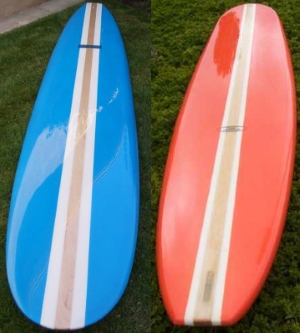The evolution of surfboards
- Matt Rosas
- Jun 3, 2023
- 2 min read
Updated: Jun 15, 2023
A Journey Through Time: The Evolution of Surfboards
Introduction:
Surfing, the art of riding the waves, has captivated humans for centuries. Since its inception, surfboards have undergone a remarkable evolution, transforming from simple wooden planks to technologically advanced creations. This 2000-word exploration traces the history of surfboard evolution, highlighting key milestones, influential figures, and the revolutionary designs that shaped the sport we know today.
Origins of Surfing:
Surfing has its roots deeply ingrained in ancient Polynesian cultures, particularly in Hawaii. Dating back thousands of years, the early Hawaiians developed the art of wave riding using wooden planks called "olo" or "alaia." These early surfboards were relatively small, lightweight, and maneuverable, allowing the rider to perform graceful maneuvers on the face of the wave.
The Influence of Europeans:
The arrival of Europeans in the Pacific marked a significant turning point in surfboard evolution. In the 18th century, explorers and missionaries encountered the sport in Hawaii, introducing it to the Western world. Europeans began to adopt and adapt the traditional Hawaiian surfboards, resulting in larger and heavier versions known as "papa he'e nalu." These boards featured increased length and added stability, making them more suitable for non-Hawaiian surfers.
The Transition to Solid Wood:
During the early 20th century, surfboard construction shifted from solid wooden planks to hollow wooden boards. These hollow boards were lighter, more buoyant, and easier to maneuver. Tom Blake, a pioneering figure in surfboard design, developed the first hollow surfboard in the late 1920s. Blake's design featured a hollow interior, with a thin layer of wood covering the outside. This innovation revolutionized the sport, providing surfers with increased maneuverability and speed.
The Advent of Foam and Fiberglass:
In the late 1940s, surfboard construction underwent a radical transformation with the introduction of foam and fiberglass. Bob Simmons, often referred to as the "father of the modern surfboard," experimented with these materials to create lighter and more buoyant boards. Foam cores were coated with fiberglass and epoxy resin, resulting in a durable and lightweight structure. This breakthrough led to a surge in popularity as surfers embraced the newfound maneuverability and increased performance of these boards.
Shortboards and the Revolution of Surfing:
The 1960s brought about a significant paradigm shift in surfboard design with the emergence of the shortboard. Inspired by the Australian surfer Bob McTavish and his V-bottom design, surfboards became shorter, narrower, and more responsive. These shorter boards allowed surfers to perform more radical maneuvers, facilitating the birth of modern-day progressive surfing. Legends like Nat Young and Midget Farrelly played pivotal roles in popularizing the shortboard revolution, forever changing the sport.
Thrusters and Fin Systems:
The 1980s witnessed another milestone in surfboard evolution with the introduction of the thruster fin setup. Simon Anderson, an Australian shaper, invented the thruster, featuring three fins positioned in a triangular pattern. This configuration provided surfers with increased control, responsiveness, and the ability to execute sharper turns. The thruster design quickly gained popularity, becoming the industry standard and remaining so to this day.
High-Performance Materials:
In recent decades, surfboard design has seen a surge in technological advancements and the use of high-performance materials. Epoxy resin, carbon fiber, and other composite materials have allowed for the creation of lighter, stronger, and more flexible boards. These innovations enhance performance, durability, and responsiveness, catering to the evolving demands of surfers across various wave conditions.
Malibulongboards.com surf school




























Commenti